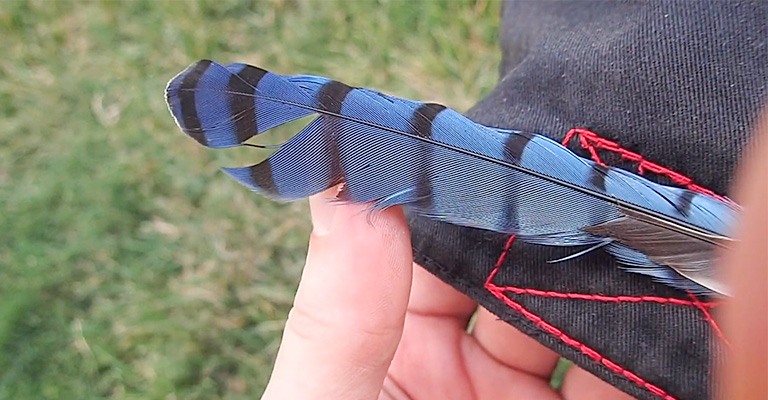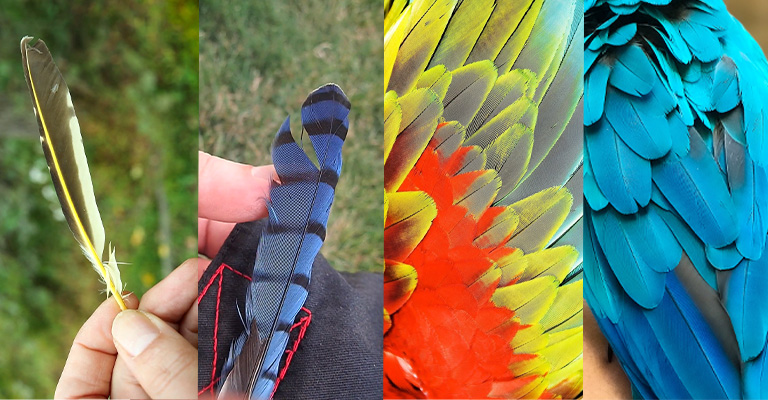The first thing we notice is the feathers of a bird when we are at a bird sighting. Feathers can be exceptionally important when you want to identify a bird.
You may often notice a feather in your backyard. And, if you are well experienced, you can already know which bird it is just by a look at it.
That’s why, being a bird enthusiast and especially knowing about feathers can help you a lot. To help you learn even more, we are here for you.
Let’s learn a bit of detail about bird feather identification. Read our article thoroughly and you will learn how to tell which bird it is just by looking at it.

Bird Feather Identification
The first question to hit your mind could be, why bird feather identification is important?
There are about 10,000 bird species known to our knowledge. But the number is said to be double when you take account of the yet-not-discovered birds.
Birds are colorful and available in different shapes and sizes. While breast bands, behaviors, and tones are effective factors in identifying a bird, feathers offer an extra layer of information.
It is useful when you are dealing with cues that are not readily available. Keep in mind that, it’s not just a feather! You can draw a lot of information from here. Let’s check out.
Feathers Offer Additional Information About A Bird
You can naturally learn more from a feather than its body features. For instance, the cockatiel feather is spotted while love bird feathers are vibrant and shady.
Here’s an overview of the information you can get from feathers.
- Species: Birds have unique feather patterns, colors, and shapes. With a feather, you can easily identify the species of a bird.
- Age: Juvenile birds frequently display different plumage than adults. Pay attention carefully and it might help you determine the age of the bird.
- Gender: Males and females reveal different feather patterns. So, when you have a pair of birds, you can easily identify between the two birds and set them ideally.
- Molt Patterns: Feathers are arranged differently and shed through different stages of a bird’s life. It can provide detailed insight into a bird’s life cycle and death.
- Home and Behavior: Not just about age or gender, it can also reveal information about a bird’s habitat preference, diet, and behaviors. Professionals especially bird enthusiasts benefited from this.
Here! You can tell a lot about a bird from their feathers. But to be an expert, you should get the depths and learn more about the structure and types of bird feathers. Let’s take a look at it.
Type of Birds Feathers

Primarily, there are three types of bird feathers but not limited to. We will get you a deep dive into other kinds of feathers also. It starts here,
Three Primary Feathers
- Contour Feathers: The largest feather in your bird’s body is the contour feather. It generally covers the body of a bird and is also found in other parts of the body, except the beaks, legs, and body.
Contour feathers determine the bird’s overall shape and provide insulation. It also defines the color of the bird. You may not know but contour feathers only have colors at the end of it, the part that’s visible to us only.
The foundation, however, lacks color and light to insulate the body. - Down Feathers: A bird’s body needs to trap air inside. The trapped air helps to reduce the rate of heat loss, ultimately keeping the body warm.
The down feathers do this part and offer insulation to a bird’s body. They are fluffy and pushy and lie beneath the contour feathers. In short, they are not visible to us and may not be so effective in the identification of birds.
However, often the presence of down feathers can indicate that a bird is a nestling or juvenile. Some birds like Herons have special down feathers called Powder Down.
The down feathers for herons are never molted. Rather, they collect some dust and set them to their feathers.
At times of need, it breaks up into fine powder. The Heron then covers its body with the powder and it works as a water repellent.
- Flight Feathers Also known as, Remiges, are found on the wings and are responsible for generating lift and propulsion during flight. Birds have two main types of flight feathers,
Primary Flight Feathers: The feathers are long and located at the tip of the wings. Primary flight feathers of birds are arranged differently for every bird. It also varies in size too. Hence, it contributes highly to identifying different species of birds.
Secondary Flight Feathers: The secondary flight feathers are located behind the primary flight feathers, near the body. Flight feathers have barbules that offer them more strength during their flight.
When you are identifying a bird, the three feather types mentioned here are enough. They reveal specific colors and patterns, making them unique to each other.
You can, however, keep notes on other types of feathers too just to learn more about the diversity of birds.
- Tail Feathers (Rectrices): They make up the bird’s tail and deliver a significant role in the steering and stability of flight. Tail feathers are especially notable in birds with long feathers.
- Covert Feathers: Smaller feathers that cover and protect the bases of the flight feathers on the wings and tail.
- Semiplume Feathers: Somewhere in between down and contour feathers, semiplume feathers can be defined. They are often hidden under the contour feathers and improve the bird’s aerodynamics.
- Filoplume Feathers: Slender, hair-like feathers with a sensory function, they help to maintain the arrangement of the contour feather.
- Bristle Feathers: Stiff, hair-like feathers found around a bird’s eyes, beak, and sometimes around the mouth. They are often sensory organs and can be useful field marks in certain birds.
Now you know what signals the feathers provide you when it comes to identifying birds. But, there is still a lot more to learn about birds.
Want to Learn More?
While feathers can be a valuable tool for bird identification, it’s important to remember that they are just one part of the puzzle. You must also learn about other features such as beaks, crest, etc. They are important factors in addition to bird feather identification.
Luckily, we offer regular updates on birds and useful tips to keep them safe. Keep in touch with us to learn more about these beautiful creatures. Also, don’t forget to share our article with your friends. We will come back with more.